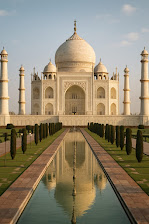The Taj Mahal also known as the 'Symbol Of Love', located in Agra city, Uttar Pradesh, India, is one of the Seven Wonders of the World. It is a mausoleum (a building housing a tomb or group of tombs) built between 1631 and 1648. Situated on the right bank of the Yamuna River, the complex spans nearly 17 hectares.While it is widely known that the Taj was built by Mughal Emperor Shah Jahan as a memorial for his beloved wife Mumtaz Mahal, there are several lesser-known facts that add to the monument’s aura and mystery.
According to legend, the Taj Mahal appears to change colours at different times of day- soft pink in the morning, dazzling white in the afternoon, golden-ish during evening, and bluish or silvery at night. These changing colours supposedly represent the different moods of Mumtaz Mahal at different times of day/.
The tombs seen by most tourists are false tombs while the real tombs of Mumtaz Mahal and Shah Jahan who was also buried there after his death are hidden in a sealed chamber on the lower level.
A popular myth claims Shah Jahan cut off the hands or killed the architect Ustad Ahmad Lahauri to prevent him from building another Taj. However, there is no evidence of this.
The mughal gardens have a clever underground plumbing system designed for symmetrical irrigation.
While Taj Mahal was built in India, it has architectural elements of other countries too. For instance, The calligraphy is Islamic, the dome is taken from Persia, and the minarets are similar to those in Turkey.
The Taj Mahal is rumoured to once be inlaid with real jewels lke diamonds, rubies, sapphires etc. However, most of these were looted during invasions.
The Taj mahal is perfectly symmetrical, except the tomb of Shah Jahan which was added later and wasn't part of the original design breaks the symmetry.
During WW2, it was hideden by bamboo scaffolding to disguise it from enemy borders.
It creates an optical illusion. When viewed from the main entrance, it appears large and close but as you go closer, it apprears to shrink.
These rare facts reveal the genius and mystique surrounding the Taj Mahal. It’s not just a symbol of love, but a masterpiece of engineering, artistry, and cultural fusion that continues to fascinate the world.

Comments
Post a Comment